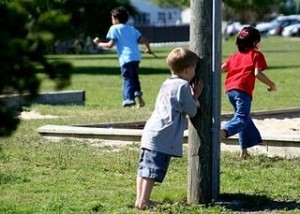“17…18…19…20. Ready or not, here I come!” With those words, a new round of “Hide and Seek” began. Children scrunch into their hiding places, giggly with excitement. They become as small as possible behind a stump, up in a tree, under a bush. The one who is “it” stalks carefully around the yard, watchful for traces of those who are hiding.
 I remember the feeling of hiding. As the seeker got closer to my hiding place, my heart pounded faster, I held breath, trying to be invisible. Then, suddenly, I’m found. I remember a rush of delight, energy, and relief as I burst from my hiding place.
I remember the feeling of hiding. As the seeker got closer to my hiding place, my heart pounded faster, I held breath, trying to be invisible. Then, suddenly, I’m found. I remember a rush of delight, energy, and relief as I burst from my hiding place.
Once everyone is found, the game begins again.
The rules for “Hide and Seek” are pretty simple, but important. One crucial component of the game is to establish agreed-upon boundaries. If the space available for hiding is too narrowly defined, there is no challenge. Hiders and seekers soon lose interest. If the area for hiding is too broad the game becomes frustrating for the seeker and boring for the hiders.
I remember one kid who hid too well and too far away. He was simply left out there when the rest of us went in for supper. I guess he eventually got hungry and went home.
As in the child’s game, clearly defined boundaries are crucial in adult relationships. The boundaries must be sufficiently broad to keep things interesting, but also sufficiently circumscribed so that the two people can find each other without becoming too frustrated. In relationships, however, boundaries are not simply defined by physical space.
 There are all kinds of useful boundaries. For example, it doesn’t take long for each person to know what words or tone of voice will inflict pain, impose silence, or trigger an explosion in the other. Therefore, a couple may need verbal boundaries. “We will not scream or use insults as ways of expressing our anger.” “We will not use the silent treatment for more than 24 hours.” “If things get too intense, either of us can call ‘time out’ for some time apart.”
There are all kinds of useful boundaries. For example, it doesn’t take long for each person to know what words or tone of voice will inflict pain, impose silence, or trigger an explosion in the other. Therefore, a couple may need verbal boundaries. “We will not scream or use insults as ways of expressing our anger.” “We will not use the silent treatment for more than 24 hours.” “If things get too intense, either of us can call ‘time out’ for some time apart.”
Some couples may also need to set boundaries about physical contact in order to secure the safety and participation of both people in working out differences. “We will never hit or throw things at one another.” “We will not use sex as a means of avoiding conflict.”
Boundaries may be useful when addressing a wide range of concerns such as money, time apart and time together, physical and emotional space, duties and chores, ways of being together in public.
As a psychotherapist I have encouraged couples to use time as a safe and useful boundary when considering divorce. For example, “We agree not to separate or threaten divorce for the next three months (or whatever time frame seems both safe and workable to both). During that time we will put our energies into assessing and reforming our relationship.” At the end of that time they can either proceed with divorce, nurture the hope they discovered, or negotiate additional time to assess. Such time boundaries can assure each that the other is still in the game.
Sexual or emotional fidelity is another form of boundary. Sexual fidelity is not simply a prohibition. It is a boundary to keep both people’s sexual and emotional energies and investment in the game they have agreed upon.
An exciting game of Hide and Seek requires clear and challenging boundaries. Few things sap the fun and energy out of a game or out of a relationship faster than boundaries that are too narrow, too broad, or unclear. With poor or unclear boundaries, the relationship becomes a source of concern and anxiety rather than a resource for comfort and energy.
The object of Hide and Seek and of a relationship, after all, is not to be too easily found, nor is it to stay hidden indefinitely. The object is to find new ways of discovering each other.
“17…18…19…20.” The child whirls around excitedly. “Ready or not, here I come.” Those in hiding giggle with the nervous anticipation of being found.
Printed in the Abilene Reporter News September 25, 2011 http://www.reporternews.com/news/2011/sep/25/boundaries-are-crucial-in-adult-relationships/

0 Comments until now